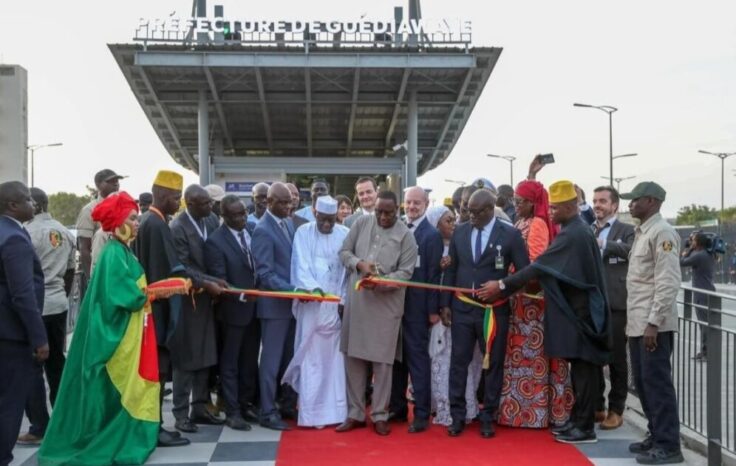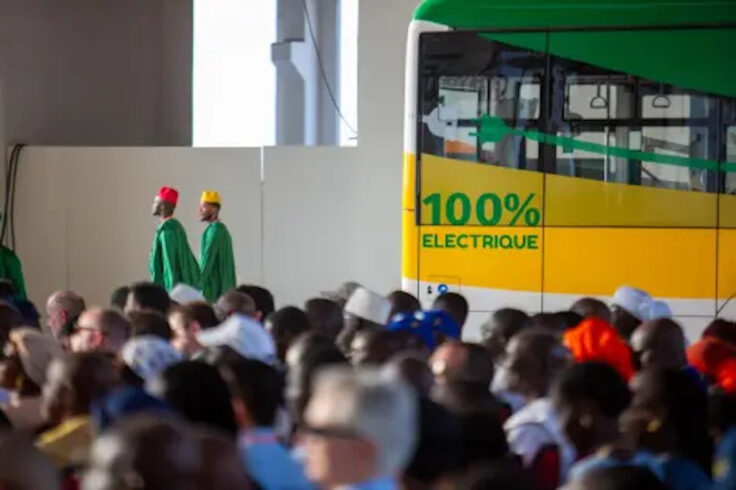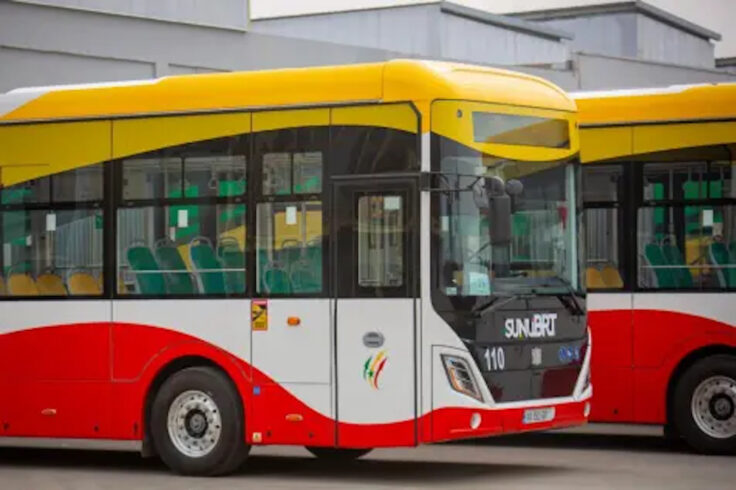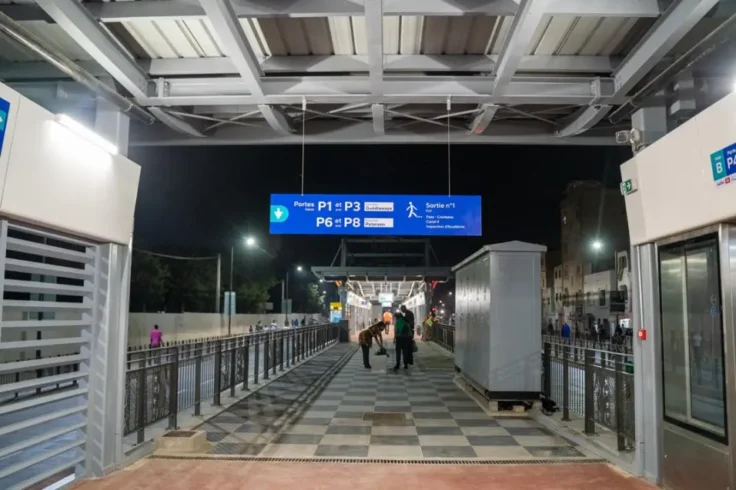March 22, 2024
Dakar, Senegal’s Electric BRT Leads the Way for African Cities
The city of Dakar, Senegal recently launched its much anticipated 18.3-kilometer, fully electric BRT, a first for this type of system in the Africa region.
Read more about the Dakar BRT on ITDP Africa’s Transport Journal.
The BRT system is expected to carry 300,000 passengers a day and reduce travel journey time from 95 to 45 minutes for a wide variety of riders. The system is set to operate a robust fleet of 144 articulated e-buses, spearheading a transformative shift towards zero emission urban transport for African cities. A mode shift from private vehicles and driving is possible with better quality and more modern public transport systems like electric BRT.
Dakar’s system incorporates quality inclusive designs along stations and pedestrian facilities, ensuring accessibility for many transit-dependent communities, including women, children, and persons with disabilities. Key design attributes include level boarding platforms, at-grade pedestrian crossings, walkways, cycle tracks, inclusive bus designs and adequate street lighting to improve public safety, especially for women and other vulnerable groups.

One of the most exciting aspects of the BRT system is the shift to fully electric buses using solar-generated renewable energy. The buses are equipped with a robust battery capacity of 560 kWh, enabling sustained operations. With a charging power of 120 kW, they require approximately size hours to achieve a full charge. Real-time bus monitoring has been incorporated, to ensure the buses are charged based on passenger demand.
Dakar is arguably the first city in the Africa region to attempt to formalize the informal bus system and also involve the private sector in the renewal of citywide bus fleets. Like many African cities, Dakar has a long history of using informal transport and, in recent years, the city’s Conseil Exécutif des Transports Urbains de Dakar (CETUD) has been working to address the declining quality of public transport services, first with a fleet renewal and service upgrade initiative in 2005.
Informal operators participating in the project were required to form cooperatives which would be responsible for loan repayments for the new fleet, initially financed and guaranteed by the government with credit from the World Bank. The government was able to regulate services through concession agreements, which enabled government oversight in the overall. quality of services. Major changes included removing older vehicles, the development of specified routes and fares, strict pick-up and drop-off points, and the use of ticketing slips for proof of payment.

The development of this system has generated overall public transport improvements with the renewed fleet, although enforcement of conditions to improve service quality was slow and gradual over the years. Planning for Dakar’s BRT began around the same timeframe and offered improved service delivery through larger buses that facilitated economies of scale, better system monitoring through intelligent transport systems (ITS), and dedicated median lanes for time savings.
The city of Dakar began to explore the potential BRT after some preliminary presentations by ITDP Africa to CETUD and other local decision-makers. ITDP sent Enrique Peñalosa, the former Mayor of Bogotá, Colombia, and other experts to Dakar to hold workshops as part of a Building a New City tour. Former Senegal President Abdoulaye Wade and other top government officials expressed great interest in replicating many of Bogotá’s experiences with sustainable public transport. ITDP also prepared the first Dakar BRT feasibility study with support from USAID, helping to identify the travel patterns in the city and possible BRT routes based on congestion levels, travel demand, minimal land acquisition, road capacity, and other strategic opportunities.

Learn more about BRT in ITDP’s 2024 Edition of the BRT Standard here.
The study also identified the projected demand by evaluating existing commute frequencies, origin and destination patterns, city density and evaluation of mode shift patterns and trends among other factors. The findings were used to model future scenarios for the different corridors. The recommended operations also focused on prioritizing high-demand corridors and the use of a trunk and feeder system to increase the capacity of the BRT system, especially given the limited road space in the city.
In addition, bus driver behavior would be more easily enforced in a trunk feeder system, solving the key challenges in the bus service formalization process. Once the BRT system planning was in place, ITDP also contributed to the design process, ensuring universal standards and key BRT basics (such as fully dedicated right-of-way, busway alignment, platform-level boarding, off-board fare collection and intersection treatments) were all incorporated. The operations model also leveraged inter-modal connectivity with the Train Express Regional (TER) system, having each terminus serving the 32 feeder bus routes that are part of the BRT system.
The World Bank and the European Investment Bank financed the construction of the Dakar BRT. The bus fleet was financed, procured, and operated by the private sector through a 15-year concession agreement signed in 2021. The private sector partner, Dakar Mobilité, constitutes Meridiam and Fonds d’ Investissement du Sénégal (Senegal Investment Fund, or FONSIS) have a 70/30 shareholding agreement. The overall private sector investment amounts to USD $144 million, with an additional USD $22 million financed by the World Bank’s Multilateral Investment Guarantee Agency (MIGA).

The risks to the private sector are mitigated through clearly outlined risk and role allocation in the operating agreement, including a minimum revenue guarantee and minimum passenger guarantee set at 100,000 passengers per day. The operator is expected to collect revenues as well as maintain the necessary infrastructure. The government, on the other hand, will ensure adequate operations and passenger volumes on feeder services. The BRT fares are zone-based and were set based on affordability through preference surveys and existing fares as well as the financial viability of the concession.
To accommodate lower-income and marginalized groups, estimated to constitute 17% of potential riders, the system will charge a reduced fare of 50% of the normal rate. The government will pay USD $17 million to the concessionaire over the 15-year period to offset the revenue loss due to the reduced fare. It is also worth noting that, since the project is deemed financially viable, the concessionaire is expected to pay a concession fee to the government.
To ensure improved ridership and inclusive operations, CETUD is working with other stakeholders on campaigns which also involve opportunities for women. Out of the 1,000 jobs created, 35% will be allocated to women. The BRT system already has one female driver, which is not very common in a region like Dakar. In addition, gender-based violence mechanisms are being set up to ensure safety for women and girls as well as ensure responsive reporting mechanisms.
The Dakar BRT system is a great example of how cities can reduce urban transport emissions through shift-avoid-improve policies. Drawing on ITDP’s own compact cities electrified modeling, these strategies have shown the greatest potential benefits for reducing greenhouse gas emissions and keeping global warming below 1.5 degrees.
By advocating for active mobility, creating mixed-use neighborhoods, and planning more accessible rapid transit systems, all African cities can follow Dakar’s model for a future of sustainable transport.
